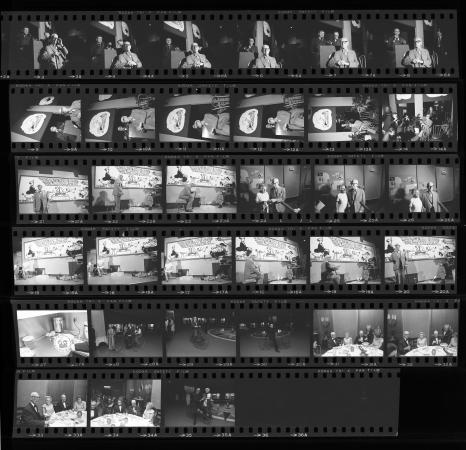On November 24, 1970, the National Museum of History and Technology (NMHT), now known as the National Museum of American History, opened an exhibition highlighting the work of Reuben “Rube” Lucious Goldberg. The exhibition, "Do It the Hard Way: Rube Goldberg and Modern Times," featured cartoons, sculptures, several animated films, and Goldberg’s famous wacky machines that initiated a string of events designed to perform otherwise simple functions in funny and inefficient manners. The exhibition was curated by Peter Marzio under the direction of historian Daniel Boorstin.

When many people hear the name Rube Goldberg, they may think of overengineered or complex ways to accomplish tasks, which is the very definition of Rube Goldberg machines. The contraptions used air pressure, gravity, human touch, levers, and more to initiate a chain reaction to accomplish a simple task like brushing teeth, turning on a light, or taking a picture.
Goldberg also created fun and wacky cartoons, like Mike and Ike, Sideshow, and Boob McNutt. In 1948, he won a Pulitzer Prize in Editorial Cartooning for “Peace Today,” a political cartoon with a more serious tone, which depicted the angst felt after the deployment of the atomic bomb and what it meant for the world. Through satire, Rube Golberg aimed to show the ugly truth of how the horrors of war and hate can lead to extreme tragedy.
In an episode of Radio Smithsonian titled, “The Creative World of Rube Goldberg,” Goldberg spoke about his journey and what he thought of the machines. Despite the fact that some people consider him an inventor, Goldberg didn’t think of himself as mechanically inclined. He described his machines as “satirical representations of progressive nothing.”
In a separate interview with journalist Emily Nathan for Smithsonian Radio in 1970, Goldberg expressed how pleased he was with the Museum’s efforts to highlight his work. He spoke about his use of contraptions in his cartoons and how they ignited the spark to actually build the machines. The cartoonist described how some of the machines in the exhibition would work, including one that took pictures of the visitors after it pushed air through a tube, forcing a sailboat to move forward on ice, popping a balloon, causing a “dictator” to faint, and then landing on the trigger to snap a picture.

The Smithsonian Institution Archives has films, audio, newsreels, and other footage capturing the excitement of the Museum and its visitors surrounding this exhibition. Goldberg did get to see the opening of the exhibition he spoke so proudly of in this interview. However, he passed away 13 days later on December 7, 1970, at the age of 87.
Goldberg is renown for his creative and complicated contraptions that make the simplest tasks a long and drawn-out process, which to this day, is still making waves throughout society. The self-proclaimed “crazy inventor” who did not did not take himself too seriously has since inspired people around the world to use Rube Goldberg machines in many creative and funny ways. Today, his family runs a not-for-profit, Rube Goldberg Inc. (RGI), which for over 30 years has held contests supporting STEM and STEAM education. There are many organizations and private citizens that participate and create these engineering feats.

In the 1970 interview for Radio Smithsonian, Goldberg spoke about his drive and devotion for the work, in spite of late nights, and stated:
“I knew what I wanted to do, and I knew that I, I had to make good and I, because I had great doubts about whether I would...get to where I wanted to. But, uh, I was full of ambition; I did all this work and I was very lucky it came out. I, I think you have to be very lucky. Luck...I'm a great believer...”
Related Collections
- Smithsonian Institution Office of Telecommunications, Productions, 1970, 1995-1996, undated, Accession 06-250, Smithsonian Institution Archives
Related Resources
- “Goldberg’s Inventive Wit Comes to MHT,” by Mary Krug, Smithsonian Institution Archives, Record Unit 371
- The Creative World of Rube Goldberg, Episode #27, Radio Smithsonian, Unlocking the Airwaves, Maryland Institute of Technology in the Humanities (MITH)
- “The Story Behind Rube Goldberg’s Complicated Contraptions,” by Emily Wilson, Smithsonian Magazine
Produced by the Smithsonian Institution Archives. For copyright questions, please see the Terms of Use.

Leave a Comment